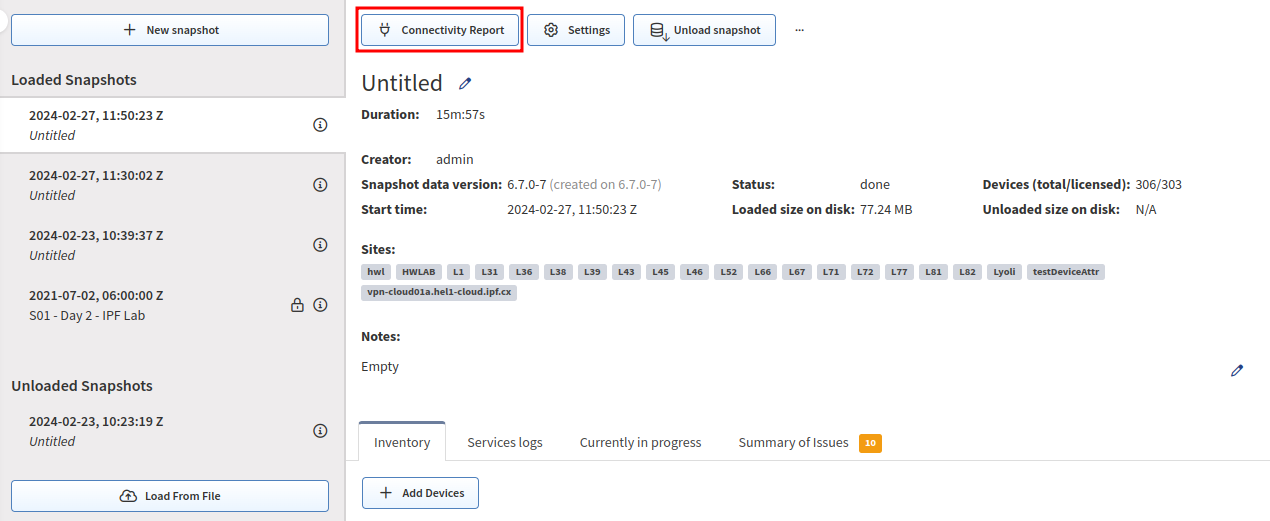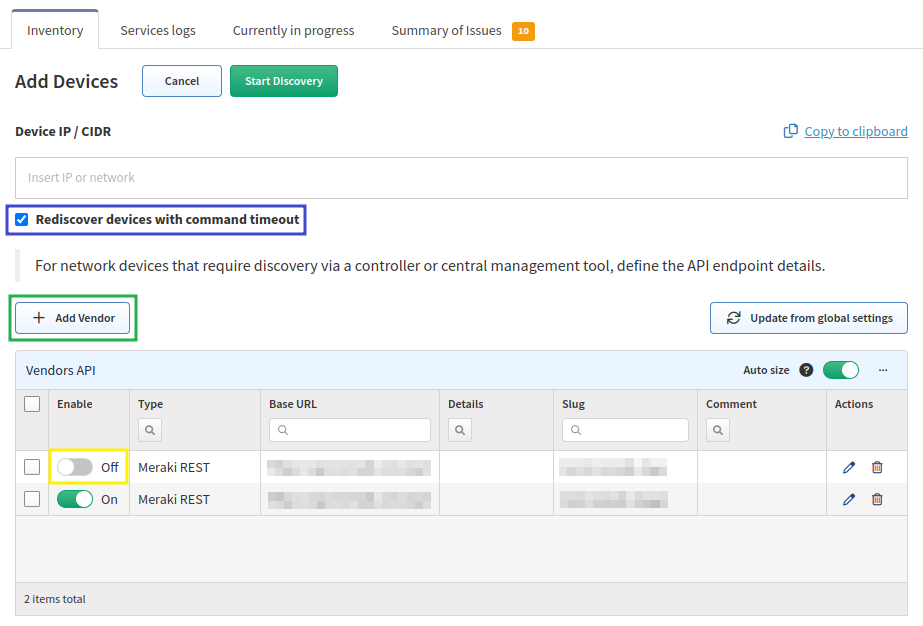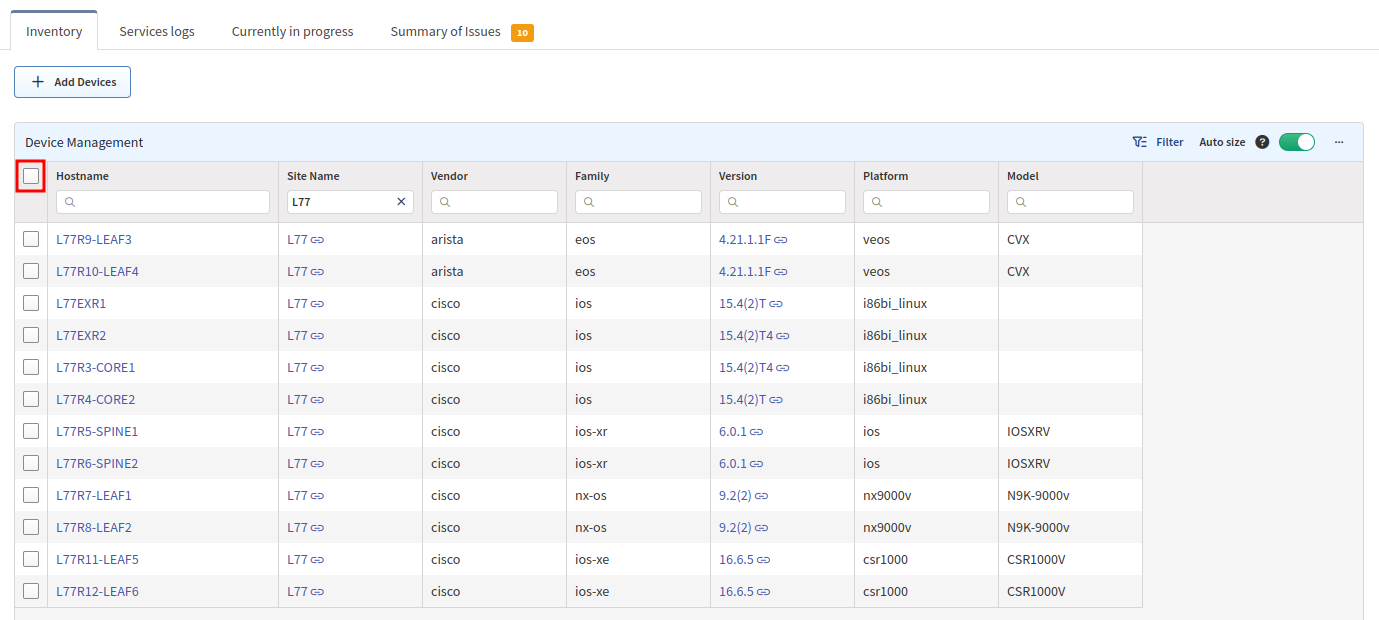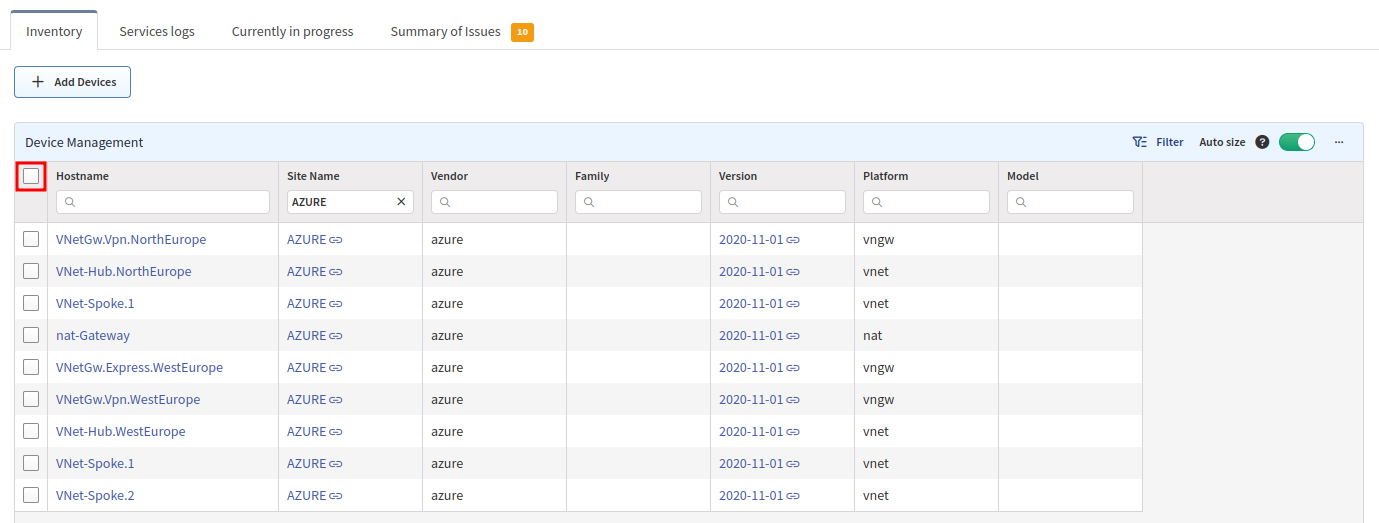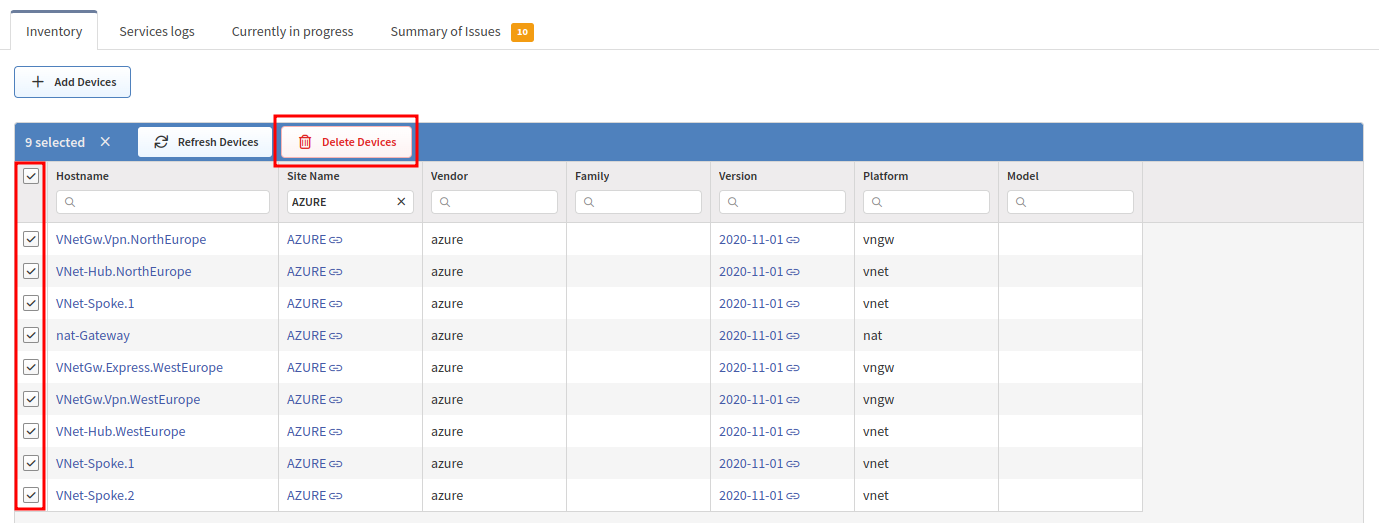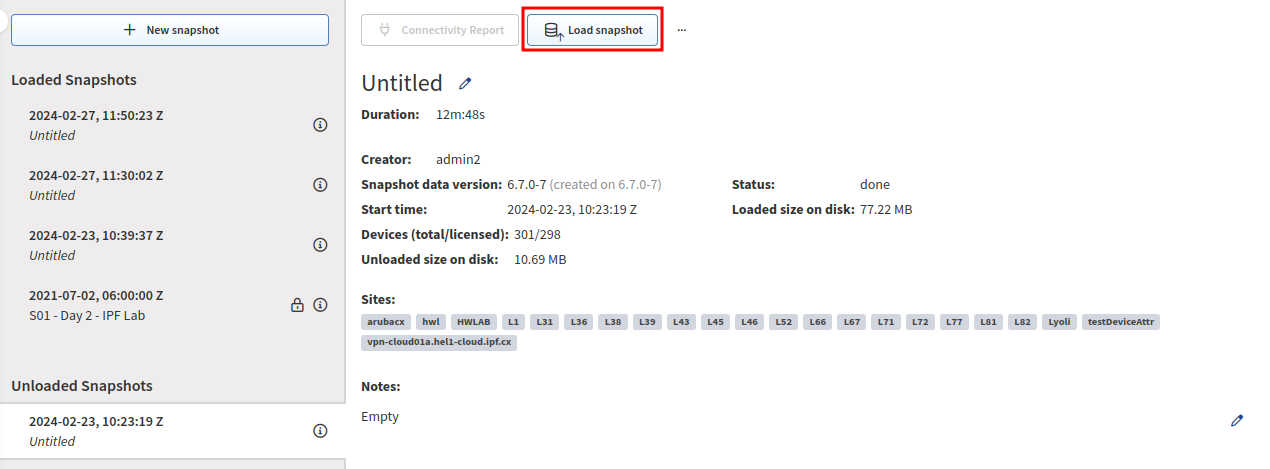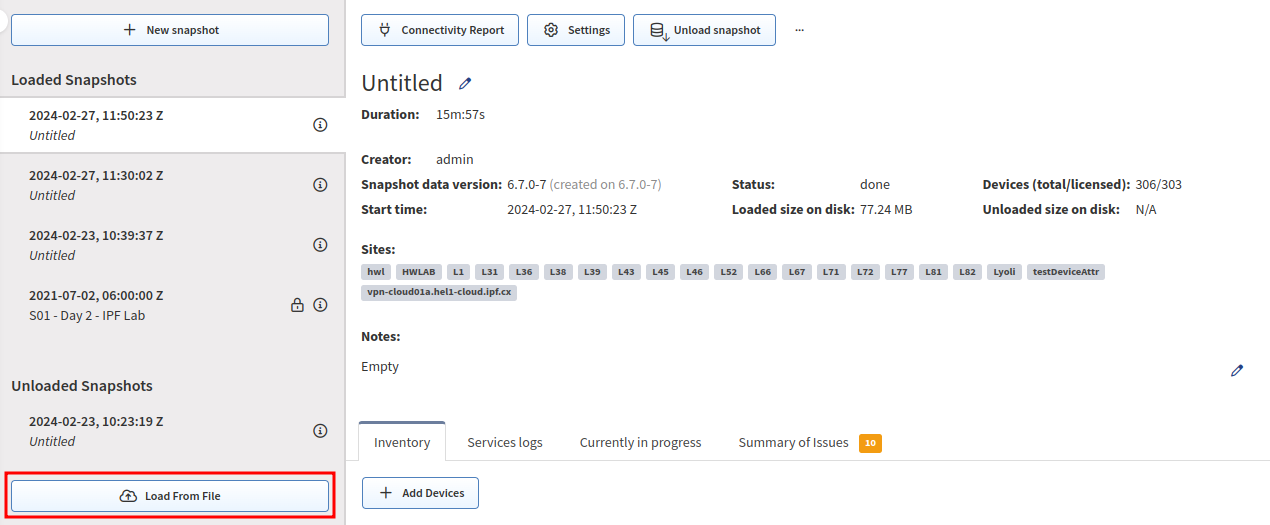Discovery Snapshot
Overview
A network snapshot records:
- The state of the network at the time the snapshot was taken.
- All service logs, logs used internally by the IP Fabric system, as well as a log of commands issued to every network device.
- Connectivity issues that occurred during the retrieval of the snapshot.
A network snapshot is a fully functional software copy of your network, including all configuration and state data. It enables the retrieval of historical information, tracking network state changes, analyzing connectivity issues, and more.
The network information displayed in IP Fabric corresponds to the network snapshot selected in the Current Snapshot drop-down menu in the left panel.
New Snapshot
To work with snapshots, click the Discovery Snapshot menu entry (highlighted in the yellow box). This will display all loaded and unloaded snapshots and allow you to create new snapshots or perform operations on existing snapshots.
A new snapshot can be taken at any time by clicking + New Snapshot (highlighted in the red box) and then the green Start discovery button. This will start a new snapshot of the network with globally set parameters in the Settings menu entry. If you need to make some changes to the discovery process (add a new network seed, change login credentials, etc.), you may do so in the global Settings or in the snapshot-specific settings (highlighted in the blue box).
For creating automatic snapshots, follow the instructions in Create Snapshots Periodically.
Resource Checks Before Creating a New Snapshot
Before creating a new snapshot, IP Fabric performs the following resource checks (if any of them fails, a new snapshot won’t be created):
-
The size of the largest loaded snapshot plus 5 GB is lower than the available disk space.
- If this condition is not met,
Not Enough Disk Spaceis thrown.
- If this condition is not met,
-
The average in-memory size of loaded snapshots plus 3 GB is lower than the available RAM.
- If this condition is not met,
Not Enough System Memoryis thrown.
- If this condition is not met,
-
Even if the new snapshot would have the size of the largest loaded snapshot, any locked snapshots would not be automatically deleted based on the
Delete Snapshots: If HDD utilization reaches ... percentvalue (default 80) set in Settings → Discovery & Snapshots → Snapshot Retention.- If this condition is not met,
Not Enough Disk Spaceis thrown.
- If this condition is not met,
In case of ongoing issues, it is possible to disable these resource checks in
/opt/ipf-api/conf.d/api.json. Please contact IP Fabric Support for such a
change.
Stopping Discovery
While discovery is running, it can be stopped (highlighted in the red box) at its current state, preventing any further network device discoveries.
The snapshot will then begin the topology calculation and Assurance Engine process for the devices discovered up to that point.
The snapshot will enter a Stopping state (highlighted in the red box), and the message Network topology building has been started (highlighted in the green box) will be displayed.
Data from the snapshot will be partially available, and no other actions will be performed until the process is complete.
Force Stopping Discovery
If you don’t want to wait for the Assurance Engine process to finish while stopping discovery, you can use the Force Stop option.
To ensure UI access is maintained after a discovery Force Stop, any system jobs scheduled to start afterward will be cancelled.
The snapshot will enter an error state and be marked as Force Stopped with a note stating: The discovery process was force-stopped, data may be inconsistent and unusable.
Snapshot-Specific Settings
Adjusting the settings for either a new snapshot or a previously created snapshot will override the global Settings. This is useful, for example, for testing different SSH settings, Site Separation rules, or authentication methods.
Difference between snapshot data version and software version
The Software version (displayed in the top-left corner) indicates the version of the IP Fabric product.
The Snapshot data version (visible in the middle of the screenshot) represents the version of IPF migrations. The Snapshot Data Version (visible in the middle of the screenshot) represents the version of IPF migrations. This value is crucial for determining whether the snapshot needs to be Unloaded and Loaded again after an upgrade, or if it can be retained as-is.
Inspection of Network Issues
The initial snapshot of the network may not include all information about your network. This could be due to a variety of reasons, including authorization or firewall issues; please take a look at Troubleshooting Discovery.
Each successful or unsuccessful connection attempt is logged (see the following picture). Logs for each device can be found in the snapshot’s Connectivity Report (highlighted in the red box). These logs are especially helpful when an error occurs. By examining them, you can find the reason why a device wasn’t correctly or fully discovered or what led to a connection failure.
Modifying Snapshot Devices
Adding Devices
A new device can be added to an already existing snapshot by clicking the + Add Devices button (highlighted in the red box). You can then add a list of IP addresses or subnets to be tried in discovery and added to the currently selected snapshot. This might be desirable if you performed almost a full snapshot of the network, but only a few devices were not included or had connectivity issues that were later resolved (for example, wrong AAA configuration, firewall rules, forgot to include a network seed, etc).
When adding a new device to an existing snapshot, the snapshot-specific settings will be applied. To add a new device to an existing snapshot, you need to first change the settings (for example, add a new network seed, login credentials, etc.) for that snapshot and then add the device.
If the Rediscover timed out devices checkbox is selected (highlighted in the blue box), the discovery will try to rediscover any devices that previously timed out. To speed up the addition of new devices, it is recommended to unselect this checkbox. If you would like
to only rediscover devices, that is also possible by not entering any new device IP addresses and clicking the green Start Discovery button.
Finally, it is also possible to + Add Vendor (for discovery via API; highlighted in the green box) or enable a previously disabled Vendor (highlighted in the yellow box) in the currently selected snapshot. Please note that toggling a Vendor from on to off will not remove that Vendor’s devices
from the snapshot. However, toggling all the Vendors to off will prevent IP Fabric from rediscovering those devices, thus speeding up the addition of new devices (similarly to disabling Rediscover timed out devices).
Refresh Devices
The Refresh Devices action will make the snapshot rediscover the selected devices and update the data models. You can manually select certain devices or, as shown in the example above, filter by the Site L77 and refresh all devices in that site.
Please note that changes in those devices might affect other devices, such as when a routing change is propagated throughout the network. A good example of using Refresh Devices is for a firewall change, ensuring the new rules are correctly allowing or denying traffic in Path Lookup simulations.
Delete Devices
The Delete Devices action allows you to manually select certain devices and remove them from the snapshot. When devices are removed and were previously being displayed in Network Diagrams or Path Lookups, IP Fabric
will then show a transit cloud indicating it does not have information about the next destination or connected device.
Snapshot Actions
Due to database maintenance, only up to 5 snapshots can be loaded into memory. The default configuration allows only 3 loaded snapshots, but you can change this in Settings → Discovery & Snapshots → Snapshot Retention → Maximum number of loaded snapshots.
Lock Snapshot
By selecting Lock snapshot, IP Fabric won’t automatically unload the snapshot to the hard disk and will keep it in memory. The default configuration allows only 1 locked snapshot, but you can change this in Settings → Discovery & Snapshots → Snapshot Retention → Maximum number of locked snapshots.
Loaded Snapshots
If the maximum number of loaded snapshots is set to 5 and there are already 5 loaded snapshots when a 6th snapshot is created or loaded, IP Fabric will automatically unload the oldest loaded snapshot from memory and save it to the hard disk. This can also be done manually for a selected snapshot by clicking Unload snapshot.
Unloaded Snapshots
When a snapshot is unloaded, it is safely stored on the hard disk, but the data from that snapshot cannot be accessed directly through the IP Fabric user interface. To browse an unloaded snapshot, it needs to be loaded again to memory by clicking Load snapshot.
Snapshot Retention
It is important to note that there are Snapshot Retention rules in place that will delete snapshots after the hard disk space utilization reaches a certain threshold.
- For more information, please see:
Download Snapshots
If needed, a selected snapshot can be downloaded from IP Fabric to your local storage by selecting Download snapshot.
Clone Snapshot
Both loaded and unloaded snapshots can be cloned with Clone snapshot. This is handy if you want to make some changes to the snapshot (such as adding a device), but you want to keep its original version as a backup.
Delete Snapshot
Snapshots can be deleted using Delete snapshot.
Load Snapshot From File
A downloaded snapshot can be loaded back onto the IP Fabric platform with the Load From File button.
Create URL Pointing to Specific Snapshot
You can add the selectSnapshot argument to any URL in the GUI to point to a specific snapshot.
Example:
https://your-ipfabric-instance/inventory/devices?selectSnapshot=ad61c08c-c179-4142-8c95-3628228bc3df
After opening the link, the specified snapshot will be selected as the current one in IP Fabric.
Related Articles
If you want to learn more about how network discovery works from a technical point of view, read:








